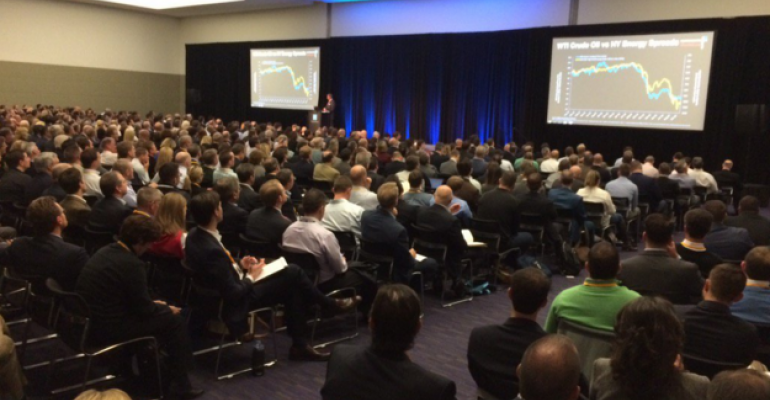Though chances are good that U.S. central bankers will raise the federal funds rate in December, it will have a profoundly negative impact on the economy and the markets, Jeffrey Gundlach, CEO of DoubleLine Capital, told a standing-room-only crowd at Schwab’s annual IMPACT conference.
Gundlach suggested that while there was lukewarm support for a rate hike on the Fed committee, and political pressure to implement one, the economy is too fragile to support it with the price of oil falling and the value of the dollar shooting skyward. He did, however, give the crowd two investment ideas he deemed a “no brainer,” Puerto Rico muni bonds and closed end funds.
Given the plunge in energy prices, headline inflation has turned negative in recent months, and PriceStats, which tracks prices paid in online retail, has fallen 1 percent. “Inflation is nowhere to be found,” he said, running counter to the Fed’s target of 2 percent. Gundlach suggested the current situation is “weird” and one where the European central bank officials are looking at further quantitative easing with their economies registering 1.5 percent GDP growth, while the U.S., at just over 2 percent GDP growth, seems poised to take away the punch bowl by raising rates.
“You cannot have quantitative easing and raise interest rates,” he said. “My theory is there is simply not enough global GDP to go around.”
While core inflation (less energy and food) is nearing 2 percent, the Fed has made it known it tracks the personal consumption expenditure index, which has turned negative in recent months. “The PCE deflator is interfering with the Fed’s holiday party,” he said. The Fed could rest their case on hourly earnings growing 2.5 percent, Gundlach said. Couple that with a rally in S&P 500 over the past three months, and that could give cover for the Fed to make its first move in years.
But the rally in the S&P 500 is deceptive, and not a sign of the economy’s overall health, he said. It’s nearing 19 times trailing 12-month earnings, and corporate earnings are falling. When corporate earnings fall 60 basis points that’s often usually followed by a recession. “Now is the time to derisk your portfolio,” Gundlach said.
Another warning sign is the fall in the price of junk bond funds, which are well off their peak a year ago. “If there is anything that should ring the clarion call against raising rates, that should be it,” he said. Plunging energy prices are throwing more companies into junk bond territory, and rising defaults are only a matter of time, he said, comparing investors in junk bond funds to the guy who gives keeps giving loans to his out-of-work brother-in-law. “After awhile, you realize you’re not getting that money back.”
“I’m beating the drum loudly against Junk bonds,” he said.
Gundlach also dismissed investment managers who suggest a rate hike would not be “that big of a deal.” “Two-thirds of asset managers have never even experienced a rate hike,” he said. “It’s a big deal.” Managers running leveraged funds “are all going to have to get small all at once.”
Gundlach did give two areas where investors can find value: Puerto Rico municipal bonds and closed-end funds. Puerto Rico municipal bonds are yielding 11.5 percent, and “triple-tax free,” he said. For a California resident, that’s a tax equivalent yield of 24 percent. He dismissed the notion that Puerto Rico is such an economic disaster that the bonds will go into default. “They are constitutionally required to pay them,” he said. And even if they didn’t, a restructuring would pay bondholders back at 70 to 80 cents on the dollar, or about what it costs to buy them.
As for closed end funds, which often use leverage to goose yields, they are trading at a 10 percent discount to their net asset values, as wide a discount as they get, barring the financial crisis of 2008. Yes, he conceded, you might see a 2 percent wider discount, particularly if rates go up, but the chances of those funds closing the gap are much stronger.
“You could easily see a 15 to 20 percent return,” he said. “I would much rather own that than the S&P 500. It’s a no brainer.”





